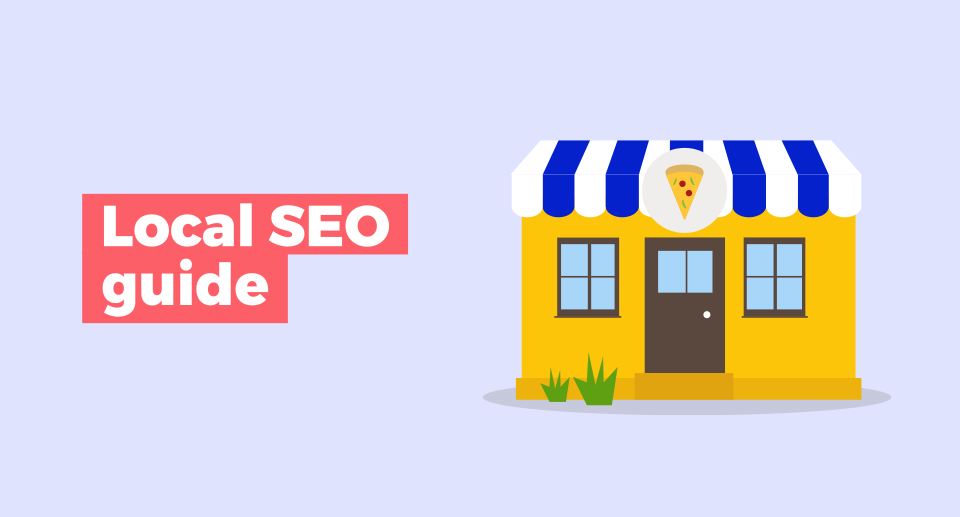Local search has become a critical component of any small business marketing strategy.
With 69% of all Google searches seeking local information, it’s essential that your business appears at the top of local search results.
That’s where local SEO comes in.
From optimizing your website with location-specific keywords and creating local business listings to managing online reviews and leveraging local directories, local SEO offers a comprehensive approach to improving your online presence within your target market.
In this guide, you will find everything you need to know about local SEO, including how to improve your local SEO, great tools for the job, and much more.
What is local SEO?
Local SEO is the practice of optimizing your website, or local business/service for better online visibility, improved rankings, more organic traffic, and in the end – more customers.
It’s all about improving your visibility in local search results, which is especially important for brick-and-mortar businesses that rely on local customers.
We’ve all seen this type of page when looking up ‘restaurants near me’ or ‘dentist [town name]’.
Businesses like these rely heavily on local SEO to make them visible to potential customers.

This image is an example of what’s called the ‘local pack’, and these results show up above other organic search results.
When optimizing for local SEO, your goal is to be in this local pack to increase your visibility.
Why is local SEO important?
The benefits may seem obvious — people see your page = people go to your website = people visit your business.
But there are more benefits to local SEO than meet the eye:
- Improved reputation and trust: Your business appearing at the top of local search results not only helps establish trust with potential customers but also allows you to manage your online reputation by providing accurate information across various online directories and platforms, ultimately enhancing credibility and trust with your target audience.
- Stronger customer relationships: By optimizing your online presence for local search, you can make it easier for customers to find and connect with your business.
- Increased revenue: Research shows that a significant percentage of consumers who perform a local search end up visiting a store within 5 miles of their location. By improving your local search rankings, you can attract more of these customers to your business and ultimately increase your revenue.
- Cost-effective marketing: Unlike traditional advertising methods that require ongoing investment, optimizing your online presence for local search can lead to sustained traffic and revenue growth over time.
a) Increased online presence & rankings
Local SEO helps your business appear at the top of local search results, which is especially important in today’s digital age.
With more and more people using search engines to find local businesses, having a strong local SEO strategy can help you increase your online visibility and attract more customers to your website.
For example, an optimized website can appear prominently at the top of the search engine results page (SERP) in the map pack when local keywords are targeted, showcasing your business to potential customers and attracting more website visitors.
b) More organic traffic
Local SEO is all about targeting customers in your local area.
By optimizing your online presence for local search, you can attract more visits to your website from people who are actually interested in your products or services.
Then, when you appear at the top of local search results, you can gain a competitive advantage over other businesses in your area.
This can help you attract more organic traffic and increase your customer base.
Interested in numbers?
- 87% of consumers used Google to evaluate local businesses in 2022,
- 42% of local searches involve clicks on the Google Map Pack.
- local searchers view 3.92 pages per session (which is significantly higher than traffic from paid search, organic search, or referrals).
c) Better user experience
Local SEO is not just about optimizing for search engines — it’s also about providing a better user experience for your customers.
By ensuring that accurate information about your business is readily available online, you can make it easier for customers to find and connect with your business.
In short, an optimized page is easier for Google to find and easier for customers to navigate.
How local SEO works
When it comes to local SEO, Google behaves a little differently.
Aside from the usual ranking factors, there are 3 signals that Google’s algorithm uses when it comes to local listings.
- Relevance: This signal determines how relevant a particular keyword is to your local business, and to the person searching for it.
- Distance: How far are you from the Google user? Someone looking for Philly cheesesteaks in Pittsburgh won’t get results from Chicago.
- Prominence: Prominence is determined by how well-known and popular your business is.
These signals work together to show users the most relevant and useful local results, but they are also influenced by smaller signals like specified locations, online reviews, backlinks, directories, and much more.
Tip: Want to learn more about the factors that go into local SEO rankings? Check out this short video by Google:
Have a look at this example from when we searched for ‘best pizza Prague’:

Here you can see the three signals at work.
For relevance, Google gave results for the keyword ‘best pizza’ or ‘good pizza’, showed businesses close to the search origin, and gave well-known restaurants with a high number of reviews and good ratings.
How to do local SEO
When it comes to the optimization of your local business, you have to cover multiple aspects of SEO:
- Perform local keyword searches
- Local on-page SEO
- Utilize Google Business Profile
- Have consistent NAP citations
- Ask for online reviews
- Start local link-building
- Add local business structured data
- Monitor & measure local SEO performance
These steps may be easier said than done, but following these practices will have you well on your way to building a healthy local SEO profile.
Let’s get into the details!
1. Perform local keyword research
By understanding the search behavior and preferences of your local audience, you can tailor your keyword strategy to attract relevant local traffic and increase your visibility in local search results.
First, let’s cover the types of keywords you’ll encounter during your local SEO research.
Local keywords can either be implicit or explicit. Implicit keywords are search queries that do not contain a location, while explicit search queries contain a city or region.
For example, the query ‘best pizza’ is an implicit keyword, and ‘best pizza downtown Chicago’ is an explicit keyword.
You can perform local keyword research in a few easy ways:
a) Use Google autocomplete: While not very accurate, it’s possible to find keywords by typing into the search bar and seeing the most popular results.
For instance, this search for ‘best cheesesteak’ came up with 10 other keyword results:

b) Try Google Keyword Planner: This tool can be used to find keywords and their local intent through Google Ads’ Ad Preview and Diagnosis tool.
However, while these tools can provide good insights, they may not always display precise data or accurate search volumes for local keywords.
c) Use KWFinder: You can use our keyword finder tool and get precise local search results from more than 50k locations.
KWFinder is very easy to use, you can simply:
- Open KWFinder and type any brainstormed or seed keyword that is relevant to your niche and business
- Select a country or type a precise location
- Choose a specific language (optional)
- Hit the “Find keywords” button
The tool will show you search volumes for any particular search query along with many useful data (such as keyword difficulty, top ranking competitors in the SERP, trend of the keyword, etc.):
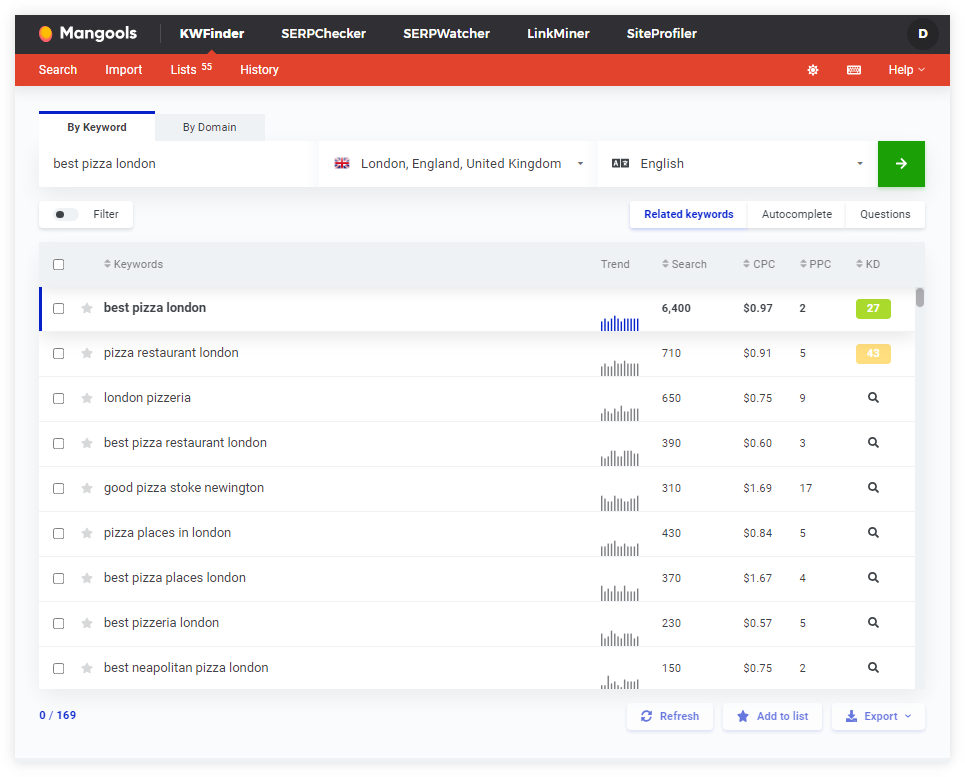
You can save your keywords and perform further SERP analysis in our SERPChecker tool. SERP analysis will give you many insights about your chosen focus keywords such as:
- Types of SERP Features displayed in the SERP
- Impact of SERP Features
- Number of ranking results
- Backlink profile of top-ranking competitors (along with useful metrics such as Domain/Page Authority (DA/PA), Website Popularity Rank (WPR), number of referring domains, etc.)
You can even take a snapshot of the SERP to actually see what it looks like in a specific region:
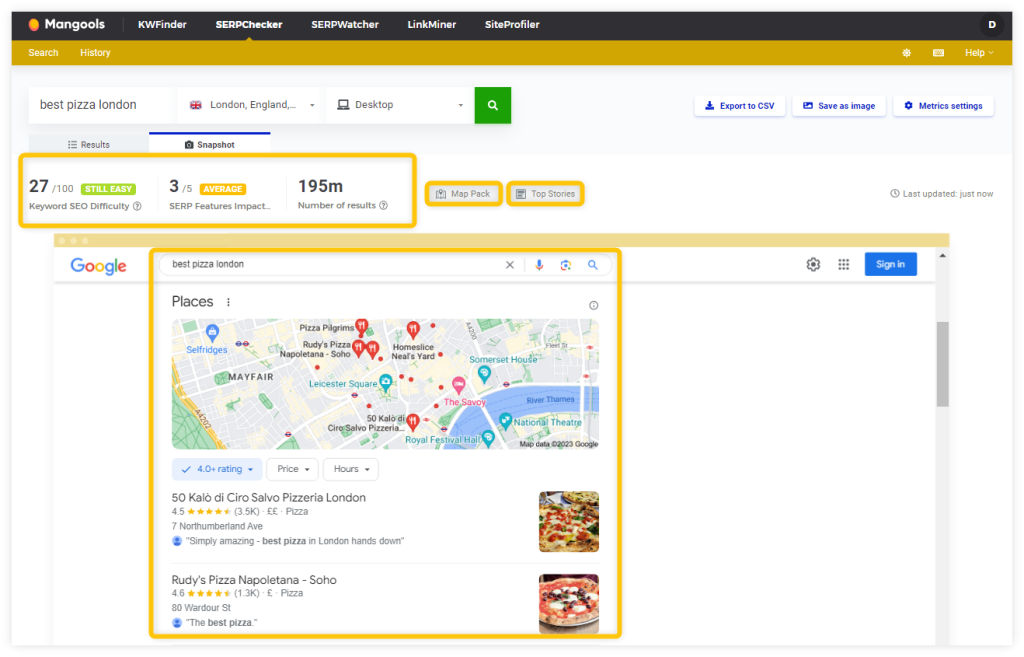
Tip: You can try KWFinder and SERPChecker, along with our other SEO tools, completely for free! (No credit card needed 😎)
2. Local on-page SEO
Local on-page SEO involves optimizing various elements on your website to target local search queries and make your website more visible to search engines.
Now that you have your local keywords ready to go, here are some key points about local on-page SEO:
- Title tags: Include relevant local keywords in your page titles to signal search engines with the geographical relevance of your content:
Title tag: Best Pizza Restaurant in Chicago | Your Website
- Meta descriptions: Craft compelling meta descriptions that incorporate your local keywords and provide a clear description of your page’s content. This can entice users into clicking on your page.
Meta description: Experience the finest Italian cuisine in Chicago at XYZ Italian Delights. Our menu features a variety of plant-based dishes made with locally sourced ingredients.
- Headings: Use heading tags (H1, H2, H3, etc.) to structure your content and include local keywords where appropriate. This helps search engines understand the relevance and hierarchy of your content, which improves your chances of ranking for local search queries.
- URLs: Optimize your URLs to include location-specific keywords when relevant.
URL: https://yourwebsite.com/chicago-italian-restaurant
- Body content: Use local keywords naturally within the body of your content. But beware, and make sure that the usage remains organic and doesn’t compromise the readability or user experience.
- Image alt tags: When adding images to your website, use descriptive alt tags that include local keywords. This gives additional context to search engines and can improve the visibility of your images in image search results.
Alt text: alt=“Logo of the best pizza restaurant in Chicago”
Tip: You can use our free Google SERP Simulator and test your title tags, meta descriptions, or even URLs before implementing them to your website.
The tool can show you how your web page would actually look like in Google SERP and help you keep an optimal length of your metadata.

3. Utilize Google Business Profile
Google Business Profile is a free tool provided by Google that allows businesses to manage their online presence across various Google platforms and display websites in the form of a Local Business snippet (e.g. for branded local keywords):
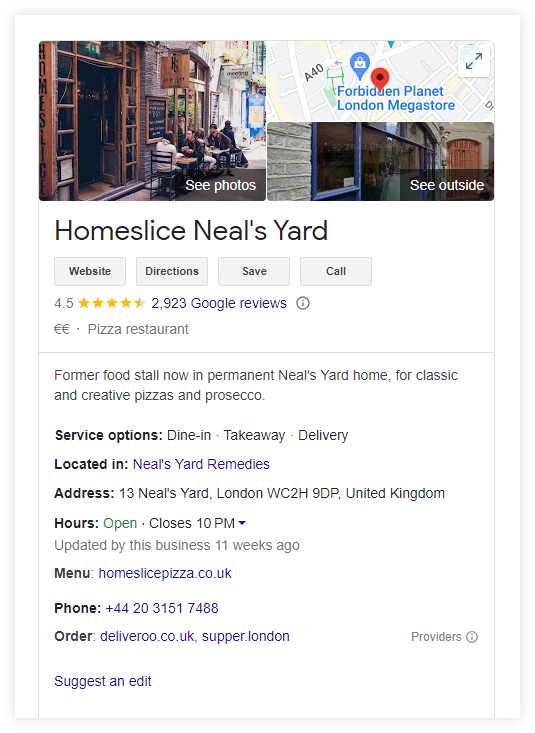
By creating and optimizing your Google Business Profile, you can improve your local search rankings, boost your share of search in Google, and attract more customers to your business. Here’s how:
- Claim your Google Business Profile listing: If you haven’t already done so, the first step to optimizing your Google Business Profile is to claim your listing. This will give you control over your business information and allow you to make updates to it as needed.
- Optimize your listing: To get the most out of your Google Business Profile, you should fill it with accurate and up-to-date information about your business. This includes your business name, address, phone number, website, hours of operation, and other relevant details.
- Add photos and videos: Adding photos and videos to your Google Business Profile can help make your listing more attractive and engaging to potential customers. People love visuals – can you remember a time you went to a restaurant that had no logos or photos?
- Encourage customer reviews: Encouraging customers to leave reviews on your Google Business Profile can help improve your local search rankings and build trust with potential customers.
4. Have consistent NAP citations
NAP stands for business name, address, and phone number. Local citations are mentions of your business on various online directories and platforms.
Building local citations and creating consistent NAP listings can help improve your local search rankings and attract more customers to your business through an improved online reputation.
NAPs are usually found in the footers or headers of web pages and in the About Us or Contact pages. To keep your NAPs consistent and build your local citations, take these steps:
- Audit your current listings: The first step to creating consistent NAPs and local citations is to audit your current listings on various online directories and platforms. This will help you identify any inconsistencies or errors in your business information. You can do this by using tools like The Hoth, Bright Local, or Review Grower.
- Create and optimize your listings: Once you’ve identified relevant directories, you should create and optimize your listings with accurate and up-to-date information about your business.
- Update your listings: Once you’ve identified any inconsistencies, you should update your listings to ensure that your citations are accurate across all platforms.
- Monitor your listings: It’s important to monitor your listings on an ongoing basis to keep your citations consistent and accurate. This can help you avoid any negative impacts on your local search rankings.
Not sure where to start?
Here are some of the most popular online directories that you can add your NAP to:
| Facebook Pages | Yellowpages |
| Bing Places | TripAdvisor for Business |
| Apple Maps Connect | Better Business Bureau (BBB) |
| Yelp for Business | Superpages |
| Foursquare for Business | Citysearch |
Note: The popularity and relevance of these business listings may vary depending on your location and industry.
Be sure to focus on the platforms that are most relevant to your specific business and target audience.
5. Ask for online reviews
Online reviews are an essential component of local SEO.
They not only help potential customers make informed decisions about your business, but they can also have a direct impact on your local search rankings.
To make the most out of online reviews, it’s important to actively monitor and manage them. Here are some tips on how to do so:
- Claim your business profiles on review sites: Claiming your business profiles on popular review sites like Yelp, Google Business Profile, and TripAdvisor is the first step to managing your online reviews. From these sites, you can monitor your reviews and get visitors on those pages to your own website.
- Encourage customers to leave reviews: Motivate customers to leave reviews on your business profiles by including links to your review sites on your website, in your email signature, and on your social media channels.
- Respond to reviews: Replying to online reviews, both positive and negative, can help show that you value customer feedback and are committed to providing excellent service.
- Monitor your reviews regularly: It’s important to check your online reviews often to stay aware of any issues or negative feedback so you can address them promptly.
You can not only improve your local search rankings when you monitor your online reviews but also build trust with potential customers and ultimately grow your business.
6. Local link building
Link building is a crucial component of SEO, and local link building can help improve your local search rankings and attract more customers to your business:
a) Reach out to local businesses and organizations: One way to build local links is to reach out to other local businesses and organizations and ask them to link to your website.
b) Sponsor local events: Sponsoring local events is another way to build local links and increase your visibility in the community.
c) Create valuable content: Creating valuable content, such as blog posts or infographics, can help attract links from other websites and improve your local search rankings.
d) Replicate competitors’ backlinks – as a part of your link-building strategy, you can perform competitors’ analysis and find out where their backlinks are coming from (and try to replicate them).
To do this, you can use a tool like LinkMiner that will make the whole process much easier – simply add a local competitor’s website into the search and check its backlink profiler.
LinkMiner will show a list of backlinks that are pointing to the competitor’s website:

You can filter backlinks according to various metrics such as Citation Flow/Trust Flow, WPR, Anchors, etc., save them and use them as a part of your link-building outreach.
7. Add Local Business structured data
Using Local Business structured data is a way to let Google know your business hours, departments within your business, reviews, and other information about your business.
This information can be then displayed in various prominent forms in Google SERP such as:
- Rich results
- Local business listing
- Carousel
- Knowledge panel
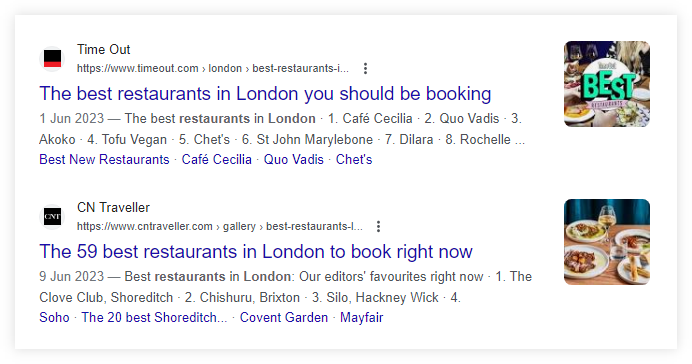
8. Monitor & measure local SEO performance
Monitoring and measuring the performance of your local SEO efforts is crucial for assessing the effectiveness of your strategies. Here are a few tools you can utilize:
a) Google Search Console: This tool helps you monitor your website’s presence in Google search results and identifies any indexing issues that may impact your local SEO. It provides valuable data on keyword rankings, impressions, and click-through rates (CTRs) for your local search queries.
b) Google Analytics: By integrating Google Analytics with your website, you can gain insights into overall website traffic, user behavior, conversions, and revenue generated. It helps you measure the impact of your local SEO on website performance and business outcomes.
c) SERPWatcher: You can use our rank-tracking tool to keep an eye on your most important local keywords and the rankings of your pages for them.
SERPWatcher is pretty easy to use – simply add your focus keywords into the tool – after some time, the tool will show you a precise position of your URLs for given keywords:
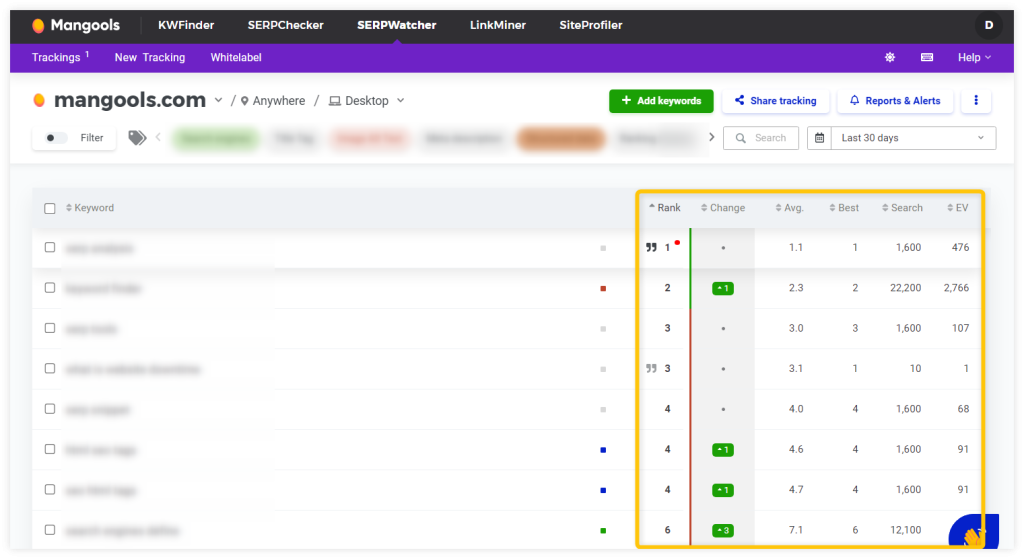
The tool can also show you valuable information about your website performance, such as:
- The overall performance index and visibility
- Major changes in your ranking positions
- Estimated visits
- Visual position (above the fold, at the fold, below the fold)
- Form of your organic snippets (featured snippets, map pack, etc.)
Local SEO strategies for small businesses
Small businesses can compete with larger companies in local search by implementing targeted SEO strategies.
Here are some effective strategies not mentioned above that can improve your local search visibility:
- Creating local content: Make content that is relevant to your local audience, such as local events, news, and attractions. This can help you establish authority and relevance in your community.
- Mobile optimization: Ensure that your website is mobile-friendly, as an increasing number of local searches are conducted on mobile devices.
- Use social media: Social media platforms, such as Facebook and Instagram, help you connect with your local audience and can promote your business. This will help drive traffic to your website and improve your local search rankings.
These are some of the most helpful strategies small businesses can use to improve their online visibility and attract more local customers.
It’s important to continually monitor and adjust your local SEO efforts to ensure that you are staying ahead of the competition and reaching your target audience!
Frequently Asked Questions
Local SEO refers to the process of optimizing your website and online presence to increase visibility in local search results. It involves targeting location-specific keywords and implementing strategies to attract local customers to your business.
Local SEO is essential for businesses that operate in specific geographic areas. It helps your business appear at the top of local search results, making it easier for potential customers in your area to find you. With the increasing use of search engines to find local businesses, local SEO enhances your online presence, drives targeted traffic, and boosts customer acquisition.
To optimize your website for local SEO, you can take these steps:
– Conduct keyword research with a local focus and incorporate those keywords into your website content, meta tags, headings, URLs, and image alt tags.
– Create a Google My Business (GMB) listing and ensure accurate and consistent NAP (Name, Address, Phone Number) information across all online directories.
– Optimize your website for mobile devices to cater to the growing number of mobile users.
– Encourage customer reviews and respond to them to build credibility and trust.
– Utilize local structured data to provide search engines with additional information about your business.
Here are some popular tools for local SEO:
– Google My Business: Helps manage your business listing and monitor performance.
– Google Search Console: Provides insights into indexing issues, keyword rankings, and search performance.
– Google Analytics: Tracks website traffic, user behavior, and conversions.
– Mangools SEO tools: Assist with local keyword research, analysis, and rank tracking.


